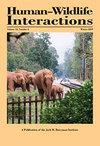Using environmental DNA to detect estuarine crocodiles, a cryptic-ambush predator of humans
IF 0.9
4区 环境科学与生态学
Q4 BIODIVERSITY CONSERVATION
引用次数: 6
Abstract
Negative human–wildlife interactions can be better managed by early detection of the wildlife species involved. However, many animals that pose a threat to humans are highly cryptic, and detecting their presence before the interaction occurs can be challenging. We describe a method whereby the presence of the estuarine crocodile (Crocodylus porosus), a cryptic and potentially dangerous predator of humans, was detected using traces of DNA shed into the water, known as environmental DNA (eDNA). The estuarine crocodile is present in waterways throughout southeast Asia and Oceania and has been responsible for >1,000 attacks upon humans in the past decade. A critical factor in the crocodile’s capability to attack humans is their ability to remain hidden in turbid waters for extended periods, ambushing humans that enter the water or undertake activities around the waterline. In northern Australia, we sampled water from aquariums where crocodiles were present or absent, and we were able to discriminate the presence of estuarine crocodile from the freshwater crocodile (C. johnstoni), a closely related sympatric species that does not pose a threat to humans. Further, we could detect the presence of estuarine crocodiles within an hour of its entry and up to 72 hours after the crocodiles were removed from aquariums. We conclude that eDNA could be a valuable tool for reducing human–wildlife conflict through early detection of the species.利用环境DNA来探测河口鳄鱼,一种隐蔽的伏击人类的捕食者
通过早期发现涉及的野生动物物种,可以更好地管理人类与野生动物的负面互动。然而,许多对人类构成威胁的动物都是高度神秘的,在相互作用发生之前发现它们的存在可能是一项挑战。我们描述了一种方法,通过使用流入水中的DNA痕迹(称为环境DNA (eDNA))来检测河口鳄鱼(Crocodylus porosus)的存在,这是一种潜在的危险的人类捕食者。河口鳄存在于整个东南亚和大洋洲的水道中,在过去的十年里,它们对人类造成了1000多次袭击。鳄鱼攻击人类的能力的一个关键因素是它们能够长时间隐藏在浑浊的水中,伏击进入水中或在水线附近活动的人类。在澳大利亚北部,我们从有或没有鳄鱼的水族馆中取样,我们能够区分河口鳄鱼和淡水鳄鱼(C. johnstoni)的存在,这是一种密切相关的同域物种,不会对人类构成威胁。此外,我们可以在鳄鱼进入一小时内以及鳄鱼离开水族馆后72小时内检测到河口鳄鱼的存在。我们的结论是,eDNA可以通过早期发现物种来减少人类与野生动物的冲突。
本文章由计算机程序翻译,如有差异,请以英文原文为准。
求助全文
约1分钟内获得全文
求助全文
来源期刊

Human–Wildlife Interactions
Environmental Science-Nature and Landscape Conservation
CiteScore
2.80
自引率
0.00%
发文量
0
审稿时长
11 weeks
期刊介绍:
Human–Wildlife Interactions (HWI) serves the professional needs of the wildlife biologist and manager in the arena of human–wildlife conflicts/interactions, wildlife damage management, and contemporary wildlife management. The intent of HWI is to publish original contributions on all aspects of contemporary wildlife management and human–wildlife interactions with an emphasis on scientific research and management case studies that identify and report innovative conservation strategies, technologies, tools, and partnerships that can enhance human–wildlife interactions by mitigating human–wildlife conflicts through direct and indirect management of wildlife and increased stakeholder engagement. Our intent is to promote a dialogue among wildlife professionals concerning contemporary management issues. As such, we hope to provide a repository for wildlife management science and case studies that document and share manager experiences and lessons learned.
 求助内容:
求助内容: 应助结果提醒方式:
应助结果提醒方式:


